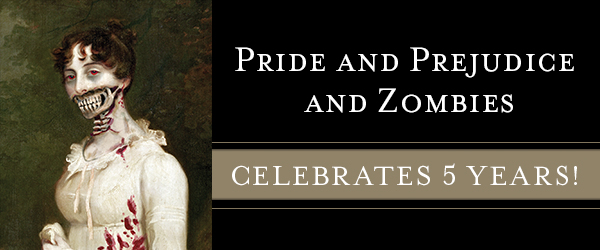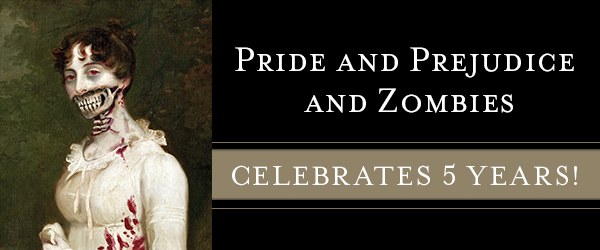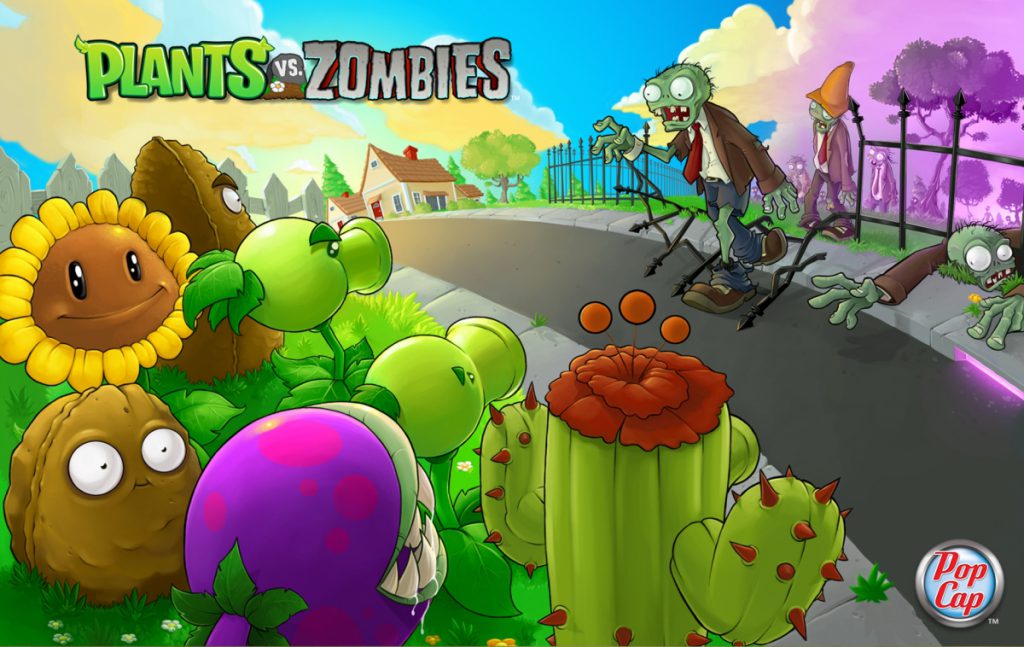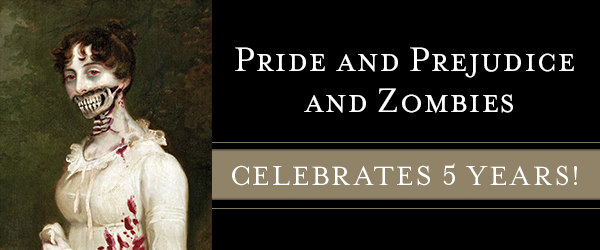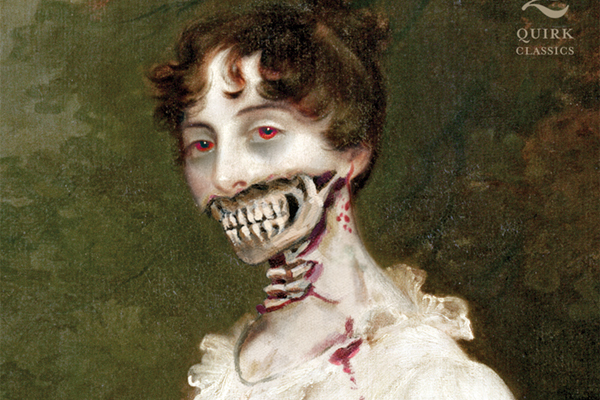Pride & Prejudice & Zombies: Part 2 of 3
[Note: Be sure to read the first part in this series, here!]
Ben H. Winters’ working relationship with Quirk Books began with Worst-Case Scenario Pocket Guide: New York City in 2009. By complete coincidence, Winters was already living directly across the street from the Quirk offices when he met Rekulak and the rest of the team at Quirk through his literary agent. While it didn’t hurt to have a local guy on board for some projects, Winters received no preferential treatment when it came to Sense & Sensibility & Seamonsters, the first Quirk follow-up to Pride & Prejudice & Zombies: his strong proposal pitch and sample chapters for the follow-up are what ultimately sealed the deal, according to Rekulak.
Zombies were great, but Quirk didn’t want to simply rip themselves off in attempt to keep their sales up. Their first follow-up kept the Jane Austen piece of the puzzle in place and mashed it up with a different beast, this time with more alliteration. “Everyone was expecting vampires, which meant it couldn’t be vampires,” explained Winters. “Everyone was expecting Quirk to make a different writer its next victim — but Austen had worked so well the first time around. Next thing I knew, I was dog-earing my Barnes & Noble classics edition of Sense & Sensibility, writing cryptic phrases like ‘secretly a merman?’ in the margins.”
Sense & Sensibility & Seamonsters, by Ben H. Winters and Jane Austen, was announced via hilarious YouTube trailer on July 13, 2009 and released on September 15 of that same year, less than six months after the release of Pride & Prejudice & Zombies. While Winters’ method of marking up the margins of the book was certainly similar to Grahame-Smith’s, the ratio of Austen-to-Awesome was slightly different this time around. “The readers who gobbled up Zombies reported back to Quirk that as much as they loved the Jane Austen stuff, they wanted a little less of it,” Winters explained.
“So my mandate on Sea Monsters was to deliver a book that was 60 percent Austen and 40 percent me. Which made my life easier: I don't know if you've ever tried to describe a city built entirely underwater, where wealthy Britons attend costume balls dressed as pirates and government scientists conduct ill-advised experiments whereby fish organs are transplanted into men, but it takes a few paragraphs.”
While it wasn’t quite as successful as Pride & Prejudice & Zombies, Sense & Sensibility & Seamonsters still did tremendously well, including a lengthy stint on The New York Times bestseller list. “Once again, to the consternation of purists everywhere, the result is sheer delight,” said The AV Club. “Winters dives into these fantastical scenarios with gusto, inventing long scenes of mayhem and mystery where Seth Grahame-Smith, who adapted Pride & Prejudice, was far more restrained…But there’s no denying the page-turning satisfaction of this welcome sequel, which exceeds Pride & Prejudice & Zombies in cleverness and wit while continuing to pay proper homage to the deep emotions underlying the original text.”
For a publisher with a previously small fiction list that took a chance on an unprecedented idea, Quirk was seeing a very clear return on their investment. Sure, they had the words of the late Jane Austen on their side, but in just two novels, they had increasingly strayed from the source texts, and while they still weren’t 100% “original fiction,” these derivative works were undeniably transformative. How much further could they go? After all, no one makes a hit just by playing safe.
#
Comedy tends to work in “The Rule of 3s” — 1. Set it, 2. Establish it, 3. Change it. Quirk had clearly established themselves with Sense & Sensibility & Seamonsters, so the next trick was to find a way to change the pattern. But instead of putting all their kraken eggs in one basket, Quirk decided to cast a wider net as they scoured the watery depths of publishing for their next big hit. Why settle for just zombies, or just an Alternate Austen story, or just a classic literary mashup, when you can have all three?
Since MechaEmma didn’t quite roll off the tongue as well as they had hoped, Quirk sent Ben H. Winters on an interplanetary journey with Leo Tolstoy that would eventually culminate in Android Karenina. While they awaited his return, Rekulak also reached out to author Steve Hockensmith with the insane idea of producing a sequel to Pride & Prejudice & Zombies, that continued the alternate history adventures of everyone’s favorite zombie-slaying couple, Lizzie Bennet and Mr. Darcy. Hockensmith had previously written several books in a Sherlock Holmes – Wild West mashup series called Holmes on the Range, which proved his familiarity with genre tropes as well as mashup conventions, even as the genre of literature came into its own.
The “literary mashup” is itself a mashup of terms, but Winters found it to be a useful, it not entirely accurate description. “Strictly speaking, a mashup (like DJ Danger Mouse’s The Grey Album) combines elements from two pre-existing works (the Beatles White Album and Jay-Z’s Black Album). These ‘Quirk Classics’ instead place one pr-existing work in an entirely new context — meaning, for my book, the creepy, there’s-something-beneath-the-surface, the-ocean-will-swallow-us-all context that’s been a staple of Western Culture from The Odyssey through Jaws." H
ockensmith agreed that the books were well within an established tradition: “as far as this genre of mashups is concerned, it’s nothing new. In the 60s there was a movie called Robinson Crusoe on Mars. It’s been done before. It’s a way to have fun. It’s a way to play on the playground and in the amusement park of literature. If we’re going to start walling off parts of the playground and say, you’re not allowed to go there, I just think that’s a loss to everybody.”
Unfortunately, Jane Austen herself never wrote any additional adventures of Elizabeth Bennet, which meant that Hockensmith would have to write an entirely original novel based on the universe and characters that had been established in Pride & Prejudice & Zombies. But as Rekulak and Hockensmith spoke, they realized that the real gem of the storytelling was not in what happened after Lizzie and Mr. Darcy fell in love — but in what happened before. “The more we talked about it the more it swung around to being a prequel because of all of these fun, unanswered questions to play with – not all of which I answered purposely, but certainly we addressed some of them and the one that I found the most interesting was the transformation of Jane Austen’s beloved and demure Bennett sisters into fierce, zombie-beheading warriors. I thought, ‘Now, that would be a fun thing to watch happen, so let’s watch it happen,’” said Hockensmith.
Of course, while the zombie action was a crucial selling point, it was even more important to capture the romance that made the original Pride & Prejudice so timeless in the first place — a particularly difficult task, when readers already knew that the story’s heroine would end up with a man who wouldn’t even be featured in the prequel. “What I tried to do is use the romances that are in the book to explain in someway, or cast some light upon, why Jane and Elizabeth would be drawn to the men they ultimately are…For me Elizabeth has one true love, and that is Darcy. I was not going to mess with that. I wasn’t going to have the tragic pre-Darcy guy who is everything that Darcy is, but dies.”
Even though the prose was completely original and based on a derivative work, Hockensmith still made sure to include a dedication to Austen in the front of the book in hopes of satiating her legions of ardent fans. “I would say that I hope our affection for Jane Austen comes through,” he explained. “That's why it was very important to me that the dedication of the book be ‘For Jane: We kid because we love.’ For me, that captures what I'm all about. I'm not doing this to flip Jane Austen the bird. I'm a guest in her home.”
The resulting prequel, Pride & Prejudice & Zombies: Dawn of the Dreadfuls was released on March 23, 2010, and became a New York Times Bestseller. It was followed by a properly sequential sequel, Dreadfully Ever After, one year later. Although nothing could match the blockbuster sales of the original Pride & Prejudice & Zombies, the books were still remarkably successful by traditional standards.
Hockensmith, too, earned his praise for his ability to capture Austen’s voice, and create compelling and entertaining stories that built upon the established “Alternate Austen” universe in new and exciting ways.
